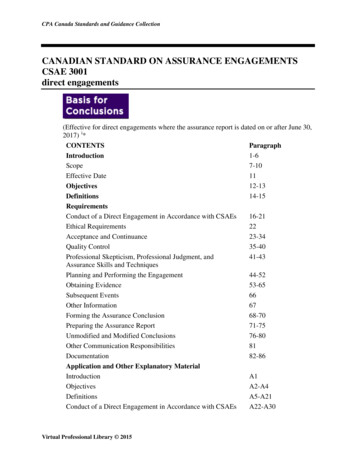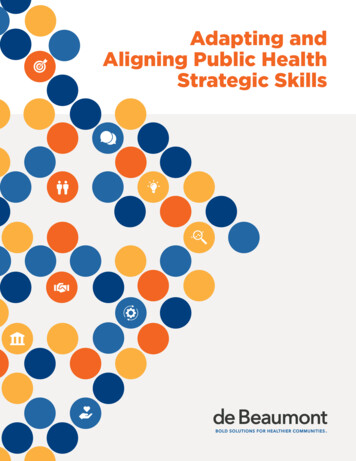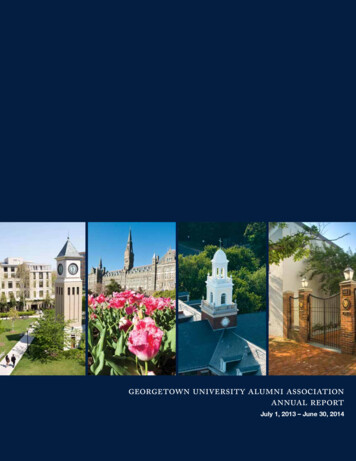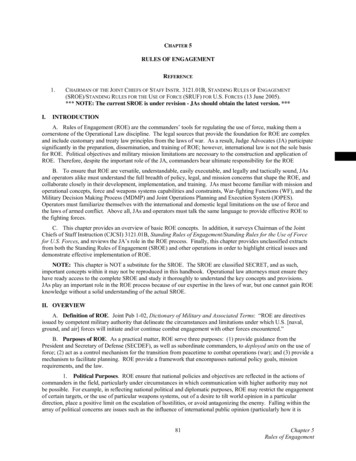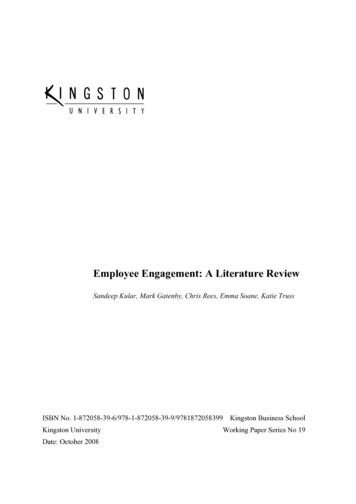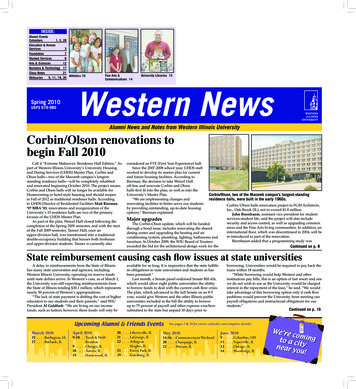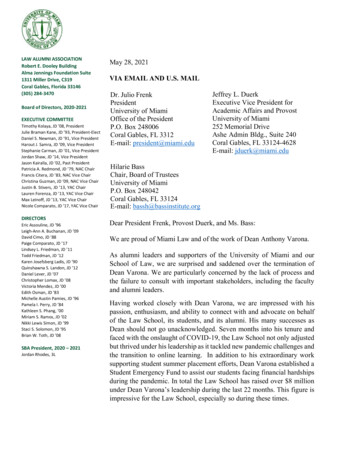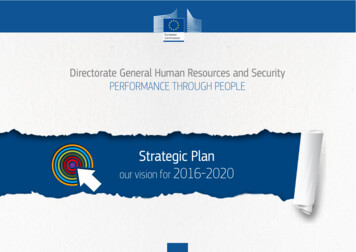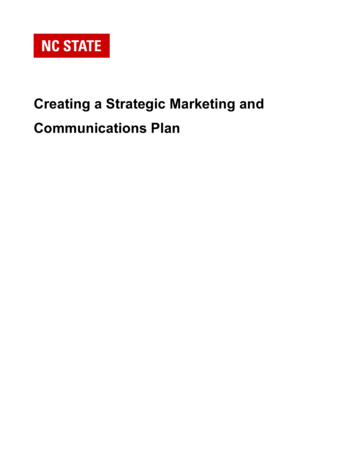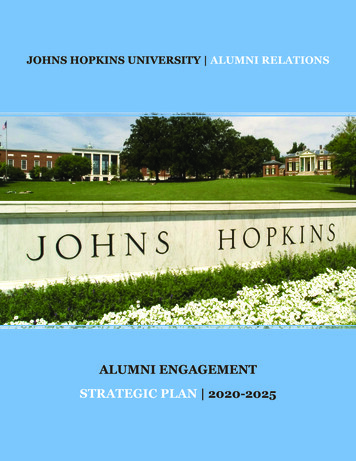
Transcription
JOHNS HOPKINS UNIVERSITY ALUMNI RELATIONSALUMNI ENGAGEMENTSTRATEGIC PLAN 2020-2025
IntroductionFrom Johns Hopkins’ earliest days, our leaders have envisioned the impactof our alumni around the world. In his inaugural address, the university’s firstpresident, Daniel Coit Gilman, described “individual scholars, who by theirexcellence will advance the sciences they pursue and the society where they dwell.”And, over the past 143 years, our graduates have more than lived up to that vision.Today, our alumni community, 222,000-strong, is advancing excellence around theworld.Our Alumni Association was seeded just a decade after the university’sfounding by graduates who appreciated the personal and professional opportunitiesafforded by their Hopkins degrees. Over time, we have evolved to meet the needs ofa larger and vastly more diverse population, constantly building new opportunitiesfor connections among our alumni and with Johns Hopkins itself.In Alumni Relations, our response to this growth has been deliberate andthoughtful, recognizing the indispensable role alumni play within our universitycommunity. In recent years, we have leveraged new technologies to reach andconnect graduates across the globe. We have built affinity programs that allow likeminded alumni to gather around industries, identities, or interests. And we havedeveloped new programs around professional growth, serving the career-focusedneeds of our alumni and allowing them to connect with current students in newways.Creating this Alumni Engagement Strategic Plan gave us a chance to step backand consider our work in new ways. We enlisted external and internal experts toundertake our first truly universitywide planning process around alumni, ensuringdivisional and central Alumni Relations offices were fully included. The process thatled to the four priorities included in this document was thorough and enlightening,while reinforcing what has always driven our work – an abiding commitment to theJohns Hopkins alumni family.This plan does not exist in a vacuum. We are guided by the mission and valuesof Development and Alumni Relations (DAR), and our work echoes tenets expressedin key university documents, including the Ten by Twenty and the Roadmap onDiversity and Inclusion. The plan will feed into a broader strategic planning processwithin DAR, and shifts in university priorities may require adjustments to our ownfocus. We are confident that this plan will help advance our shared vision overthe next five years, building connections across our university and extraordinaryalumni community.We are grateful for the work of dozens of people who contributed to the creationof this plan, and for the global Johns Hopkins alumni community – a group thatcontinues to advance excellence around the world and throughout our university.Allyson Hughes HandleySusan deMuthPresident, Alumni CouncilAssistant Vice President, Alumni RelationsThe Johns Hopkins Alumni AssociationExec. Dir., The Johns Hopkins Alumni Association1
Strategic Plan & ProcessIn October 2016, our Development and Alumni Relations (DAR) teamengaged Grenzebach Glier and Associates (GG A) to complete a universitywidereview – the first ever – of JHU’s alumni engagement programs. This reviewincluded over 50 interviews with DAR leaders, volunteer alumni leaders, AlumniCouncil members, divisional alumni volunteers, and divisional Alumni Relationsofficers.This work led GG A to recommend six key programmatic areas around whichAlumni Relations could focus future growth: Affinity programs; Career and professional programs; Off-campus programs; On-campus programs; Engagement of alumni of online and part-time degree programs; Programs for undergraduate students and undergraduate young alumni.After additional discussion, we added a seventh area: A comprehensive digital strategy for alumni.Additional information on these areas is provided in the Appendix (page 14) of this report.At GG A's recommendation, Alumni Relations completed a Gallupadministered survey of all alumni in February 2019. Survey data providedconfirmation of the goals and recommendations within the plan.GG A’s work served as a foundation as we gathered internal stakeholdersfor strategic discussions of the divisions' operations, systems, programs, andvisions. The Alumni Engagement Strategic Plan is rooted in 14 months ofresearch and discussions among constituents from central Alumni Relationsand Johns Hopkins’ nine schools. The process was guided by a 17-membercommittee, which included representatives from across DAR (annual giving,communications, Alumni Relations and major-gift fundraisers), as well as JohnsHopkins Alumni Council leadership. The committee helped define four strategicpriorities and the accompanying goals and recommendations that will shape oursuccess over the next five years.This strategic plan will serve as a guide for the Johns Hopkins AlumniAssociation (JHAA), the Johns Hopkins Alumni Council, the alumni offices of ournine schools, and the central office of Alumni Relations. Over the coming year,a strategic plan implementation committee, informed by alumni feedback fromthe Gallup survey, will help prioritize and create a timeline for the recommendedactivities, recognizing that they will not all take place at once.Following the five-year timeframe for this plan, we are confident that wecan achieve our goals by 2025, in time to commemorate the university’s historic150th anniversary the following year.2
Foundations of the WorkThis strategic plan is purposefully built from the tenets that steerDevelopment and Alumni Relations, including:The Mission:To create and foster enduring relationships that result in advocacy and philanthropicsupport for the Johns Hopkins Institution.The Guiding Principle:We are deeply committed to and aligned with the academic mission of the Institution.Our work supports its focus on research, teaching, and patient care, and its role as ahigher education leader on the global stage.The Core Values of Development and Alumni Relations: Collaboration People Relationships Integrity Innovation Trust InclusionThe Vision for Alumni Relations:Alumni of Johns Hopkins are an inclusive, global community empowered to supportthe university, its students, and one another while assisting in the university’s missionto bring the benefits of discovery to the world.We also worked to ensure the Alumni Engagement Strategic Plan reflectedbroader university values. Among the key universitywide documents that framedour work were:The Ten by Twenty, which articulates the university’s key priorities and a desireto “forge ever more enduring connections to our alumni, from whom our universityderives so much strength.”The Roadmap on Diversity and Inclusion, which expresses our commitment toinclusion and to fostering and celebrating the diversity of our growing alumnicommunity.3
Measuring Our SuccessAlumni Relations has strategically measured alumni-engagement activities –including interest in university-related events and philanthropic opportunities– since 2016. These metrics provide accountability, meaningful indicators of theimpact our work is having on alumni and on their continued engagement withthe university, and baseline data against which we can assess progress.The universitywide nature of our strategic planning process has helpedto coordinate and focus data-collection activities across our schools, ensuringwe are tracking the most relevant and revealing metrics. The all-alumni surveyconducted in early 2019 helped to assess priority interests and the current stateof engagement. From this Gallup-administered survey, early data have helpedshape and confirm our vision, and ongoing analysis will help define our baselineand refine our measurements so they align squarely with the strategic plan.Our work will include not only completing the recommendations, but alsomeasuring the impact of that work, tracking our progress across at least threekey performance indicators (KPIs): Overall participation in alumni activities; Volunteerism, as measured by the number of alumni volunteers; Donations made by alumni to the university.Each Alumni Relations office will use these KPIs to develop clear snapshotsof the current state of alumni engagement, with the intent of increasing thepercentages of engaged alumni. Within the schools and in central AlumniRelations, staff will analyze engagement trends across specific populations andover time. A strategic plan implementation committee representing all nineschools will use these findings and other inputs as it reviews priorities, goals,and recommendations on a semi-annual basis. Ensuring the plan and the KPIsremain dynamic and responsive to any shifts in circumstances, the committeewill determine whether any changes are needed, and report on progress throughthe Assistant Vice President of Alumni Relations to DAR leaders and the fulluniversity community.4
Priorities, Goals, & RecommendationsThrough the work of the Strategic Planning Committee, the AlumniEngagement Strategic Plan highlights four overarching priorities that willguide the work of Alumni Relations offices across all nine schools through 2025.After each priority, we have included a series of goals that outline specificobjectives, and recommendations for how we will approach this work acrossour schools over the next five years. We divided recommendations into threecategories – Administrative, Programmatic, and Resource-driven – to help focusour efforts.Our success in meeting the ambitious goals will remain contingent uponresources available in each fiscal year. We expect, however, that this plan willhelp determine how best to allocate staff and funding to effectively and efficientlyadvance our engagement of Johns Hopkins' exceptional alumni community.5
PRIORITY 1Provide significantpersonal and professionalopportunities for JohnsHopkins alumni to engageand connect with theuniversity.PRIORITY 1:GOALS61.Increase and improve alumni programs built around thefollowing attributes: Profession Geography School/Affiliation Shared Interest Identity A Focus on Mentoring2.Increase programming specifically for youngundergraduate alumni (less than a decade sincegraduation) to demonstrate the value of alumniengagement early on3.Develop comprehensive programming for recentgraduate alumni (less than five years since graduation)of all schools to keep them connected to Johns Hopkins4.Increase digital offerings for all alumni to reach a widerand more diverse constituency5.Further analyze the needs and preferences of alumnifrom online and part-time programs, and increaseefforts to engage these graduates, connecting them toone another, their schools, and the university
PRIORITY 1: RECOMMENDATIONSAdministrative For alumni populations of each school, identify the key regions or demographics to be considered as growth areas for engagement Define the scope and purpose of lifelong learning for Johns Hopkins alumni, and in partnership with divisions, identify existing and newopportunities for alumni Increase collaboration among regional chapters, affinity groups, divisional clubs, and young alumni committees operating within the sameregion Determine what experiences, strategies, and communication vehicles are most effective to deepen the connections between internationalalumni and JHU Develop a task force to determine best practices for universitywide reunion programming Develop an intra-advancement team to collaborate on best practices and programs for young undergraduate alumni and recent graduate alumni Within central and divisional alumni offices, create specific engagement and outreach plans for recent graduate alumni, focused on career/professional programs and general networking opportunities Identify opportunities for Alumni Relations and Development officers to reach and connect with alumni of online and part-time programs Ensure that alumni of online and part-time programs are properly coded in the alumni database and invited to participate in both central andschool-based alumni activities Share best practices among schools for hosting successful divisionally based alumni eventsProgrammatic Expand professional development programs and services, including more alumni gatherings at regional industry-specific events Develop and promote lifelong learning content targeting alumni in a variety of life stages Continue to build multidisciplinary alumni experiences that bring together diverse perspectives – including those of faculty and alumniexperts – from all nine schools Increase alumni programs and experiences hosted in Maryland, where more than one-third of JHU alumni reside Continue to grow alumni activity in emerging and highly concentrated areas overseas; identify and support local volunteer leaders inthose regions Identify and launch specific affinity groups in partnership with volunteer leaders, based on university and divisional strengths, priorities,and emerging industries Increase alumni programs offered through digital platforms (e.g. webinars, podcasts, livestreaming, etc.) Continue to expand Homecoming and Reunion activities beyond the primary weekends to establish class programming year-roundResource-driven Invest in an additional FTE (full-time employee) and program budget to ensure value and long-term sustainability of professional, sharedinterest, and social identity-based affinity groups Invest in an additional FTE and program budget for diverse new and existing identity-based affinity groups (e.g. the Society of Black Alumni(SOBA), the Hopkins Organization of Latino Alumni (HOLA), Pride – LGBTQ Community, groups representing Asian-Pacific Americans,women, etc.) Increase program budget to ensure a sustained commitment to programs for recent graduate alumni Invest in an additional FTE and budget to sustain and increase programs for young undergraduate alumni Invest in an additional FTE and budget to support regional programs, aligning our staffing with the growing interest of alumni for localconnections to JHU Invest in resources to support the unique and diverse needs of alumni of online and part-time programs, centrally and divisionally Build a centralized team – with an FTE and increased budget – to create, deploy, and manage professional digital programs on behalf of allnine schools Increase program budget to expand outreach and engagement of alumni overseas Invest in an FTE and budget for marketing and branding of lifelong learning Provide funding for Reunion-year events held off-campus throughout the calendar year7
PRIORITY 2Deepen current students’connections to theJohns Hopkins AlumniCommunity, charting clearpathways through whichthey will become engagedalumni.PRIORITY 2:GOALS1.Help students build identities as alumni, early andoften2. Increase collaboration with existing career centersand the Office of Integrative Learning and LifeDesign to leverage more professional opportunitiesoffered by alumni to students3. Improve and expand opportunities for alumnistudent mentorship4. Facilitate stronger connections among studentorganizations and alumni organizations8
PRIORITY 2: RECOMMENDATIONSAdministrative Within divisional alumni offices, establish an annual calendar of recurring touchpoints with their respective student populations Ensure key student involvement activity is recorded in the alumni database prior to graduation, or within six months after graduation Further promote the university's online career system (i.e., Handshake) as the primary platform for helping students and alumni to find jobsand internships and to share career opportunities Increase the number of students registered and actively participating on the university’s comprehensive online platform for student-to-alumninetworking (i.e., GoHopOnline) Establish a universitywide process for capturing personal/forwarded email addresses from students prior to graduation, assigning thoseaddresses within the alumni database Partner with the Office of Integrative Learning and Life Design in the development of a program that will connect students with mentors andcreating career-advancement resources and programs for alumniProgrammatic Within central and divisional alumni offices, collaborate with campus partners to support a consistent presence at all orientations and newstudent welcome events Increase the number of alumni events and experiences that are open and promoted to current students; standardize the process for includingstudents in relevant alumni communications Develop an inclusive committee of students from all divisions to assist with the planning and execution of the university’s upcoming 150thanniversary celebration in 2026 Increase the number of internships, job opportunities, and mock interviews offered by alumni to students through the university's online careersystem Within central and divisional alumni offices, establish connections between alumni organizations and student-run counterparts at the beginningof each academic year, facilitating continuing interaction as appropriate Within central and divisional alumni offices, create an annual event or experience introducing students to the Johns Hopkins Alumni Associationand helping to bolster their sense of pride in and belonging within the universityResource-driven Invest in a centralized, customized, and scalable student and alumni mentoring platform across all nine schools Increase program budget to ensure a sustained commitment to student outreach and engagement across all nine schools, with a particular focuson increasing student participation at alumni events9
PRIORITY 3Identify and developfuture alumni leaders,establishing a diverseand inclusive volunteerpipeline that willcultivate and supportincreased alumni giving tothe university.PRIORITY 3:GOALS1. Develop a multi-stage process that ensures weidentify and recruit diverse alumni leaders2. Empower our engaged volunteers to help increasealumni giving to the institution3. Evolve the Alumni Council into a broader, morediverse board that represents the demographics ofour alumni population and continues to emphasizethe importance of philanthropic support4. Leverage alumni-engagement metrics to identifyand steward potential alumni volunteers andleaders5. Identify correlations between engagement metricsand philanthropic support of the institution10
PRIORITY 3: RECOMMENDATIONSAdministrative Improve and standardize within central and divisional alumni offices the documentation of volunteer activities in the alumni database tocapture an accurate picture of volunteer engagement Within central and divisional alumni offices, develop a continuum of leadership activities and engagement opportunities along which alumnican advance Ensure that the pipeline of alumni volunteer leaders reflects the growing diversity of our alumni population Continue to train DAR staff on best practices for documenting and utilizing alumni-engagement metrics Building on current metrics, work with DAR Advancement Services colleagues to develop predictive models and dashboards to further analyzealumni engagement Increase representation of undergraduate young alumni and recent graduates from all schools in leadership roles across the university Establish consistent succession planning for current volunteer leaders, focus on identifying next-step opportunities as they finish their termsProgrammatic Improve methods of training and onboarding new alumni leaders, providing consistency and accountability across all schools and programs Create more opportunities for alumni leaders to promote and assist with university giving days and fundraising campaigns Train alumni leaders on how to promote philanthropy at alumni events and through social media outreach Empower alumni leaders with the training and toolkits to promote university messages, programs, events, and opportunities through theirpersonal and professional networks; increase the number of volunteer leaders using JHU's social media tools (i.e., Hopkins Promoters) as ameans to promote DAR communications Bring all divisional alumni leadership together annually for a joint meeting, and host geographically based alumni-leader gatherings Explore best practices related to the formation of student, young alumni, and/or recent graduate boards or councils among peer colleges anduniversities Expand opportunities for alumni of all nine schools to become more involved with the following:*Supporting the recruitment of prospective students*Mentoring and coaching current students, young alumni, and recent graduates*Providing hands-on internships and job-shadowing opportunities for studentsResource-driven Increase budget to ensure that central and divisional offices have the resources needed to create and track a diverse, universitywide alumnipipeline11
PRIORITY 4Improve the systems andinfrastructures neededto support collaborationacross Development andAlumni Relations officesat all nine schools andwith key campus partnersto maximize impact,efficiency, and excellence.PRIORITY 4:GOALS1.Increase communication, coordination,collaboration, and partnership between central andschool-based alumni-engagement programs2. Upgrade internal systems and technologicalsolutions to provide more centralized means tocommunicate, coordinate, collaborate, and partner3. Improve external platforms and software to providealumni with a more personalized, user-friendlyexperience4. Optimize alumni communications around specificinterests, preferences, demographics, and levels ofengagement12
PRIORITY 4: RECOMMENDATIONSAdministrative Standardize alumni data definitions across all nine schools and standardize practices for maintaining the quality of alumni constituent data Ensure the new DAR Customer Relationship Management (CRM) platform allows alumni to: *View their giving history*Make automated updates to their contact information (e.g. address, email, preferred gender pronouns)*Select their mail and electronic notification preferences*Self-identify their student involvement experiences*Provide feedback on programs and servicesImplement a new event-management solution that will allow alumni offices of all nine schools to more effectively plan, promote, and captureattendee information. This solution should provide:*One shared, consolidated, external calendar of alumni events*One clearinghouse for all alumni electronic mailing lists*One platform for creating and sending event invitations*One location to capture event registrations and payments as they are made*Integration of event-attendee data with our CRM*Ways for event attendees to provide philanthropic support during the event-registration process Ensure the new CRM provides user-friendly ways for Alumni Relations staff to document and monitor alumni participation and involvement Explore and implement innovative outreach methods that will better allow Alumni Relations to communicate with our ever-changing alumnibase. These technologies could include:*Text messaging to notify alumni about events and opportunities of interest to them*Subscription-based lists that will allow alumni to identify interests based on personal and professional affinities and multiple geographiclocations Drive more engagement to the online networking platform (i.e., GoHopOnline) to ensure it serves the interests of all alumni Develop and implement standards and best practices for all forms of alumni communication Improve online systems to ensure platforms translate seamlessly to mobile devices Improve the process of integrating and consolidating email messages across divisions for alumni communicationsProgrammatic Continue to build on the Alumni Council's best practice of developing divisional work teams consisting of a student, a staff member, and analumni volunteer (i.e., Key 3 Committees) Increase social media presence for the Johns Hopkins Alumni Association and for alumni of all nine schools Offer a diverse array of marketing, solicitation, and programming strategies targeted to different alumni segments based on factors such asgraduation year or level of engagement; reduce “one size fits all” messaging Increase coordination among central and divisional Alumni Relations offices to provide opportunities for alumni from all schools whenuniversity leadership and faculty are traveling for Johns Hopkins-related events Evaluate the roles volunteer alumni leaders play in external messages, with the aim of increasing alum-to-alum communicationsResource-driven Invest in an FTE to serve as a consistent liaison between central and divisional programs, to coordinate recurring Alumni Relations meetings,to advise on opportunities for collaboration, and to train on cross-campus initiatives Ensure divisional programs are properly resourced with the staffing and budget necessary to increase communication, coordination,collaboration, and partnership Invest in an additional FTE in the central alumni office and increase budget dedicated to managing and moderating a variety of online platformsand providing high-quality, social media content Increase budget to ensure optimal use of new event-management solution13
Appendix: Key Focus AreasThe following key programmatic focus areas were identified by Grenzebach Glier and Associates (GG A) aspart of their universitywide review of JHU’s alumni engagement programs:1.Affinity programs allow like-minded alumni to build and foster personal and professional connectionsaround industries, identities, and interests. The university today supports nearly three dozen alumniled affinity groups, which have grown steadily in recent years. These groups, which also provide valuableconnections among alumni, student organizations, and university partners (e.g., Johns HopkinsTechnology Ventures) show promise as ongoing drivers of student and alumni engagement.2.Career and professional programs provide career-services support to alumni, including tailorednetworking events and the use of Johns Hopkins' job platform (i.e., Handshake). These programs,often hosted by affinity, young alumni, or geographically focused groups, also provide opportunities foralumni to mentor and share professional experiences with current students in mutually beneficial ways.3.Off-campus programs include events (e.g., educational, social, family-focused, professional, andnetworking activities) that engage alumni groups across the country and around the world – fromBaltimore to Beijing, and from Nashville to New Delhi. These volunteer-driven programs that connectand gather regionally based alumni have been a longstanding strength of Johns Hopkins’ central anddivisional alumni engagement, and will continue to be a priority.4.On-campus programs are designed to bring alumni back to their alma mater, and help them followthe progress of the university and of their own division. Whether through large gatherings, such asHomecoming weekend or graduate reunions, or smaller events, such as lecture series, alumni candirectly witness Johns Hopkins’ continual evolution. These programs have grown in response to alumniinterest in recent years and will remain a priority for Alumni Relations.5.Engagement of alumni of online and part-time degree programs is essential as the universityexpands the ways in which it reaches students. Alumni of online and part-time programs must feel fullywelcome within universitywide and school-specific alumni activities, even as Johns Hopkins developsnew programs to respond to the unique needs of these graduates and ensure their voices are heardwithin the broad alumni community.6.Programs for undergraduate students and undergraduate young alumni support students’transition into the alumni community. For nearly a decade, these programs have drawn current studentsinto Alumni Relations, fostered young alumni networks in cities across the country, and built mutuallybeneficial connections between the two groups. These early engagement programs help cement ourstudents’ identities as members of the Johns Hopkins alumni community, and cultivate a pipeline oflifelong alumni supporters and leaders.7.Strategic digital engagement allows the university to leverage emerging and improving technologiesto provide high-level programs that reach far-flung alumni of all nine schools. A digital strategy wouldensure that alumni who cannot access regional or on-campus programs can stay meaningfully engagedwith Johns Hopkins through activities that might include webinars, live-streaming events, or onlinementoring of current students.14
STRATEGIC PLANNING COMMITTEESusan deMuth, Committee ChairAssistant Vice President, Alumni RelationsExecutive Director, Johns Hopkins Alumni AssociationJason Heiserman, Lead WriterDirector, Alumni RelationsTom CalderDirector, Alumni RelationsMichael CarverSr. Associate Director, Krieger School of Arts and SciencesCaitlin CoyneSr. Associate Director, Annual GivingKim Dolan (A&S '13, '18)Director of Constituent Engagement, Whiting School of EngineeringJess GillAssistant Director of Communications, School of MedicineAllyson Handley (Ed '75, '78)President, Johns Hopkins Alumni CouncilGwen HarleySr. Associate Director, Alumni RelationsRobin Hunt IngramSr. Director of Alumni Relations, School of MedicineJordi IzzardDirector of Alumni Relations, School of Advanced International StudiesWilliam Kirst (A&S '00)Communications & Outreach Chair, Johns Hopkins Alumni CouncilJay Lenrow (A&S '73)Past President, Johns Hopkins Alumni CouncilKenna LoweAssociate Director, Development CommunicationsVicky Schneider (Ed '13)Associate Director, Alumni RelationsSharon TrivinoDirector of Constituent Engagement, Carey Business SchoolD av i d Ya f f e ( A & S ' 7 4 )Past President, Johns Hopkins Alumni Council15
16
JHU ALUMNI ENGAGEMENT STRATEGIC PLANSummary1.PRIORITY 1PRIORITY 2Provide significant personal and professionalopportunities for Johns Hopkins alumni to engage andconnect with the university.Deepen current studen
visions. The Alumni Engagement Strategic Plan is rooted in 14 months of research and discussions among constituents from central Alumni Relations and Johns Hopkins’ nine schools. The process was guided by a 17-member committee, which
